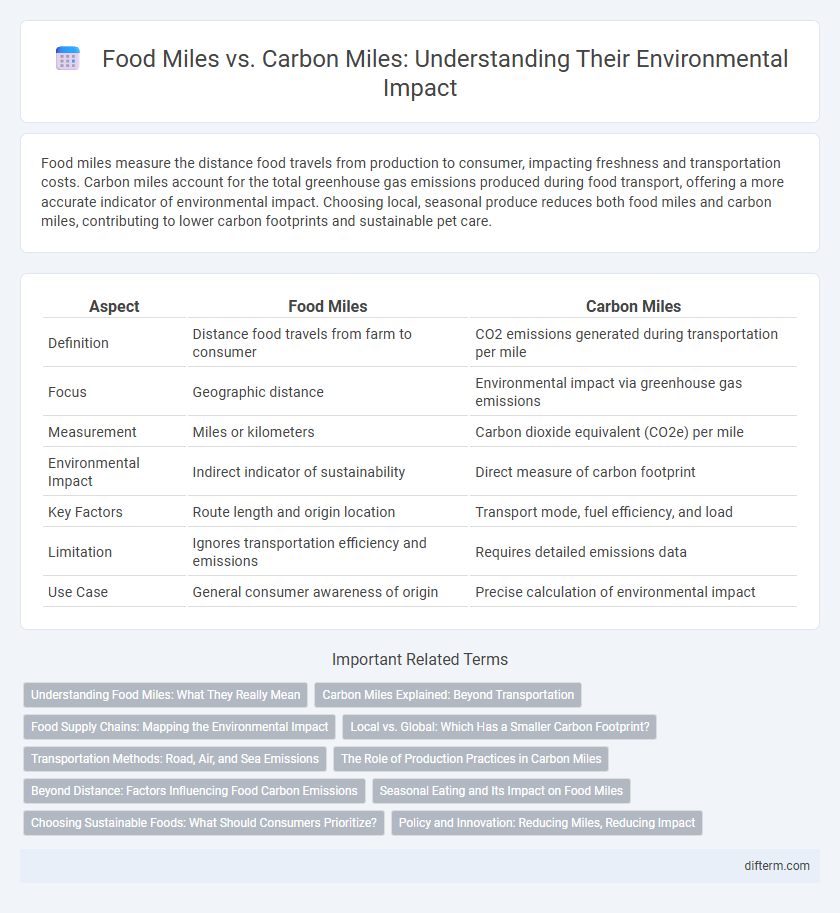Food miles measure the distance food travels from production to consumer, impacting freshness and transportation costs. Carbon miles account for the total greenhouse gas emissions produced during food transport, offering a more accurate indicator of environmental impact. Choosing local, seasonal produce reduces both food miles and carbon miles, contributing to lower carbon footprints and sustainable pet care.
Table of Comparison
| Aspect | Food Miles | Carbon Miles |
|---|---|---|
| Definition | Distance food travels from farm to consumer | CO2 emissions generated during transportation per mile |
| Focus | Geographic distance | Environmental impact via greenhouse gas emissions |
| Measurement | Miles or kilometers | Carbon dioxide equivalent (CO2e) per mile |
| Environmental Impact | Indirect indicator of sustainability | Direct measure of carbon footprint |
| Key Factors | Route length and origin location | Transport mode, fuel efficiency, and load |
| Limitation | Ignores transportation efficiency and emissions | Requires detailed emissions data |
| Use Case | General consumer awareness of origin | Precise calculation of environmental impact |
Understanding Food Miles: What They Really Mean
Food miles measure the distance food travels from production to consumer, providing a basic indicator of transportation impact on emissions. Carbon miles expand this concept by quantifying the actual greenhouse gases emitted during food transportation, offering a more precise environmental footprint evaluation. Understanding the difference highlights that shorter food miles don't always equal lower carbon emissions, especially when transportation methods and supply chain efficiency vary.
Carbon Miles Explained: Beyond Transportation
Carbon miles measure the total greenhouse gas emissions generated throughout the entire lifecycle of a food product, including production, processing, and transportation, unlike food miles which only account for the distance food travels. This broader metric highlights the significant environmental impact stemming from energy-intensive agricultural practices, fertilizer use, and packaging materials. Understanding carbon miles enables consumers and businesses to make more informed choices that reduce overall carbon footprints beyond just transportation emissions.
Food Supply Chains: Mapping the Environmental Impact
Food miles measure the distance food travels from production to consumer, while carbon miles quantify the total CO2 emissions generated during transportation and storage in food supply chains. Mapping the environmental impact requires analyzing both metrics to assess the true carbon footprint, as long-distance transport with efficient logistics may emit fewer carbon miles than local food with energy-intensive production. Understanding the interplay between food miles and carbon miles helps optimize supply chains for sustainability by reducing overall greenhouse gas emissions in food distribution networks.
Local vs. Global: Which Has a Smaller Carbon Footprint?
Local food often has lower food miles, reducing transportation emissions and supporting regional ecosystems, yet carbon miles account for the total greenhouse gases from production to consumption, which can be higher in inefficient local farming. Global supply chains may have higher food miles but can achieve greater carbon efficiency through advanced technology and economies of scale, resulting in lower carbon footprints per unit produced. Evaluating local versus global food impact requires analyzing both food miles and carbon miles to accurately assess environmental sustainability.
Transportation Methods: Road, Air, and Sea Emissions
Road transportation emits approximately 62% of total food-related carbon emissions due to heavy reliance on trucks for short to medium distances. Air freight produces the highest carbon intensity per kilometer, responsible for nearly 20 times more emissions compared to sea transport, despite accounting for less than 1% of global food transport volume. Sea freight offers the lowest carbon footprint among transportation methods, contributing to around 10-20 grams of CO2 per ton-kilometer, making it the most sustainable option for long-distance food shipment.
The Role of Production Practices in Carbon Miles
Production practices significantly influence carbon miles by determining the energy consumption and emissions during food cultivation and processing. Local organic farming techniques often reduce carbon footprints compared to intensive industrial agriculture, which relies heavily on fossil fuels and synthetic inputs. Sustainable production methods such as agroforestry and renewable energy use minimize carbon miles, emphasizing the need to assess both distance and production emissions for accurate environmental impact evaluation.
Beyond Distance: Factors Influencing Food Carbon Emissions
Food carbon emissions depend on more than just food miles; production methods, transportation modes, and storage conditions play crucial roles in the overall carbon footprint. Local foods grown in energy-intensive environments may produce higher emissions than imported items transported efficiently by sea freight. Evaluating carbon miles requires a comprehensive analysis of agricultural practices, supply chain logistics, and packaging materials to accurately assess environmental impact.
Seasonal Eating and Its Impact on Food Miles
Seasonal eating significantly reduces food miles by encouraging the consumption of locally grown produce that requires minimal transportation. Local sourcing decreases carbon emissions associated with long-distance freight, commonly known as carbon miles, thereby lowering the overall environmental footprint of food consumption. Emphasizing seasonal diets also supports regional agriculture and enhances biodiversity through diverse crop rotations.
Choosing Sustainable Foods: What Should Consumers Prioritize?
Consumers should prioritize reducing carbon miles over food miles when choosing sustainable foods, as carbon emissions better reflect the environmental impact of production, transportation, and storage. Locally sourced foods often have lower food miles but may still generate high carbon footprints if grown in energy-intensive environments or seasons. Emphasizing carbon footprint data helps consumers make environmentally responsible choices that effectively minimize greenhouse gas emissions.
Policy and Innovation: Reducing Miles, Reducing Impact
Food miles quantify the distance food travels from production to consumption, while carbon miles measure the total greenhouse gas emissions generated during transportation. Policy frameworks promoting local sourcing and investment in low-emission transport technologies significantly reduce both food miles and carbon miles, enhancing sustainability. Innovations such as electric freight vehicles and blockchain-based supply chain tracking enable transparent monitoring and optimization of carbon footprints in food logistics.
food miles vs carbon miles Infographic

 difterm.com
difterm.com